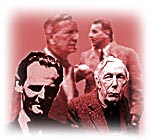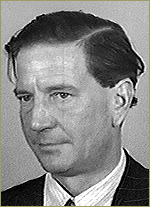











Soviet Spies - Continued
SOVIET SPY - Philby and the Cambridge Spy Ring
 The dark, windowless room in KGB Headquarters held nothing more than a chair,
rows and rows of file cabinets, and a long table. If the room had had a window,
in the near distance the walls of the Kremlin could have been seen, ablaze with lights.
The newly appointed officer sat at the table while a filing clerk piled file upon file upon it.
As he went through the dossiers, the KGB official was astonished. Here was the history of four
agents who had penetrated the highest reaches of the British intelligence establishment.
Everything that Churchill or Roosevelt or Truman had thought had been reported to the Soviets
as soon as the three great statesmen had uttered these thoughts. The files were clearly marked:
Transmission to Control, to Beria, to Stalin. No bureaucracy was to impede the flow of
information from these spies. They were too important, their information too reliable. The KGB
man smiled. KGB men rarely smiled.
The dark, windowless room in KGB Headquarters held nothing more than a chair,
rows and rows of file cabinets, and a long table. If the room had had a window,
in the near distance the walls of the Kremlin could have been seen, ablaze with lights.
The newly appointed officer sat at the table while a filing clerk piled file upon file upon it.
As he went through the dossiers, the KGB official was astonished. Here was the history of four
agents who had penetrated the highest reaches of the British intelligence establishment.
Everything that Churchill or Roosevelt or Truman had thought had been reported to the Soviets
as soon as the three great statesmen had uttered these thoughts. The files were clearly marked:
Transmission to Control, to Beria, to Stalin. No bureaucracy was to impede the flow of
information from these spies. They were too important, their information too reliable. The KGB
man smiled. KGB men rarely smiled.
The quote above just shows how important the three men we are about to tell you about really were. The so-called Cambridge Spy Ring,
penetrated the highest secret information in the West and provided the Soviet Union
with the vital information. The four were not characters in a spy novel - they were real.
The spies were Burgess, Blunt, Maclean, and Philby.
 There have been no more successful, more dramatically impressive spies than a group of Englishmen
who all met at Trinity College, Cambridge University in the 1930s. To one degree or another,
they were active for the Soviet Union for over thirty years. They were the most efficient
espionage agents against American and British interests of any collection of spies in the
Twentieth Century. One of them, Kim Philby, served the KGB for almost fifty years.
There have been no more successful, more dramatically impressive spies than a group of Englishmen
who all met at Trinity College, Cambridge University in the 1930s. To one degree or another,
they were active for the Soviet Union for over thirty years. They were the most efficient
espionage agents against American and British interests of any collection of spies in the
Twentieth Century. One of them, Kim Philby, served the KGB for almost fifty years.
All four were eventually exposed but --- amazingly --- never caught. One, Burgess,
was a flamboyant, alcoholic homosexual. The second, Blunt, was a discrete homosexual
who rose to knighthood as the Royal Curator of Art. The third, Maclean, was a tense,
insecure diplomat of ambiguous sexual persuasion. The fourth, Philby --- and perhaps
the most intriguing of the group --- was a dedicated heterosexual who has been called,
not inaccurately, the Spy of the Century.
 We will focus on the third man of the so-called Cambridge
spy ring Kim Philby -- a devoted British communist and
one of the most damaging moles in the
history of Western intelligence. Schooled at
Cambridge University, where he came in
contact with fellow Soviet spies Guy
Burgess, Donald Maclean and Anthony
Blunt, Philby entered the British Secret
Intelligence Service (MI-6), rising to highly
sensitive positions.
We will focus on the third man of the so-called Cambridge
spy ring Kim Philby -- a devoted British communist and
one of the most damaging moles in the
history of Western intelligence. Schooled at
Cambridge University, where he came in
contact with fellow Soviet spies Guy
Burgess, Donald Maclean and Anthony
Blunt, Philby entered the British Secret
Intelligence Service (MI-6), rising to highly
sensitive positions.
Harold Adrian Russell Philby was a British Secret Intelligence Service officer between 1939
and 1951. For two years, 1949 to 1951, he was SIS liaison officer with the CIA and the FBI
in Washington and thus at the heart of the Western intelligence war against the Soviet Union.
But all the while Philby was really working for Moscow and thus every Western intelligence
operation was doomed before it began.
The Cambridge spies were deceiving their colleagues, their service, their families and their country in the sincere belief that they were serving a greater cause through an elite intelligence service, the KGB,
which fathered them, mothered them, and appeared to trust them totally.
But, in turn, they were being deceived by the KGB because it really believed that
they were playing a treble game and were all traitors to the Communist cause.

 DID YOU KNOW?
DID YOU KNOW?

In fact, Philby is thought responsible for the deaths of
many Western agents he betrayed to the
Soviets.

Philby's association with fellow double-agents
Burgess and Maclean -- whom he helped
escape to the Soviet Union -- eventually led
to his downfall. Under suspicion, he was
relieved of his intelligence duties in 1951 and
dismissed from MI-6 in 1955. In 1963 he fled
to the Soviet Union, where he joined the
KGB. When he died in 1988, he was buried
with full honors in a Moscow cemetery.

With the exception of a single payment to Philby when he was financially distressed
after resigning from MI6, and travel funds for Mrs. Maclean and Mrs. Philby to assist
in their joining their husbands in Russia, the Cambridge Four were never paid for their services.
The assumption is that they were idealists, rather than spies in for it for personal gain.
The Russians, of course, still consider the Cambridge Spies, and Philby in particular,
as ideological heroes who advanced the aims of Soviet Russia in an unsettled world
that was allied against the goals of Marxism.
The British position, however, is one that moves from annoyance that Philby caused their
intelligence community such distress, to that of indifference.
Today, of course, it is well known that Harold Adrian Russell Philby was a Soviet agent within MI-6, a traitor to his own country and a man who betrayed many of the most important secrets of the Western democracies to the Soviet Union. Now Kim Philby is a legend --- a demon or an antihero, depending on one's philosophical bent. Philby himself, or a thinly disguised fictional counterpart, stalks through many modern spy novels.
--- Robert J. Lamphere, FBI Special Agent, 1986 
Click here to go on to the most dangerous American Spies in the Cold War









Designed by Alec Andronikov and Baron Geluz















 There have been no more successful, more dramatically impressive spies than a group of Englishmen
who all met at Trinity College, Cambridge University in the 1930s. To one degree or another,
they were active for the Soviet Union for over thirty years. They were the most efficient
espionage agents against American and British interests of any collection of spies in the
Twentieth Century. One of them, Kim Philby, served the KGB for almost fifty years.
There have been no more successful, more dramatically impressive spies than a group of Englishmen
who all met at Trinity College, Cambridge University in the 1930s. To one degree or another,
they were active for the Soviet Union for over thirty years. They were the most efficient
espionage agents against American and British interests of any collection of spies in the
Twentieth Century. One of them, Kim Philby, served the KGB for almost fifty years.
 We will focus on the third man of the so-called Cambridge
spy ring Kim Philby -- a devoted British communist and
one of the most damaging moles in the
history of Western intelligence. Schooled at
Cambridge University, where he came in
contact with fellow Soviet spies Guy
Burgess, Donald Maclean and Anthony
Blunt, Philby entered the British Secret
Intelligence Service (MI-6), rising to highly
sensitive positions.
We will focus on the third man of the so-called Cambridge
spy ring Kim Philby -- a devoted British communist and
one of the most damaging moles in the
history of Western intelligence. Schooled at
Cambridge University, where he came in
contact with fellow Soviet spies Guy
Burgess, Donald Maclean and Anthony
Blunt, Philby entered the British Secret
Intelligence Service (MI-6), rising to highly
sensitive positions.

 DID YOU KNOW?
DID YOU KNOW?












